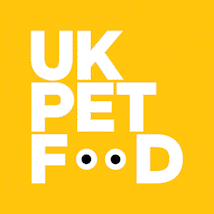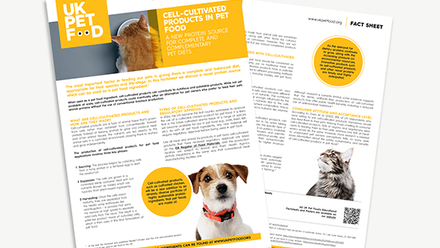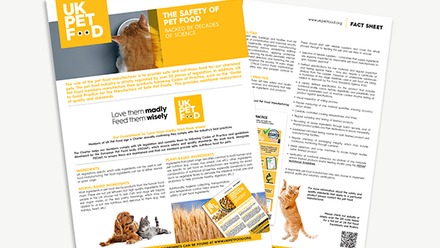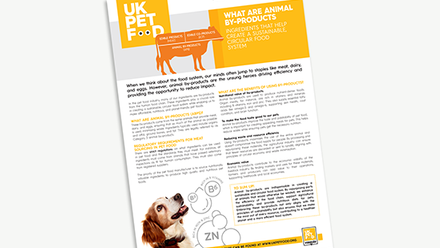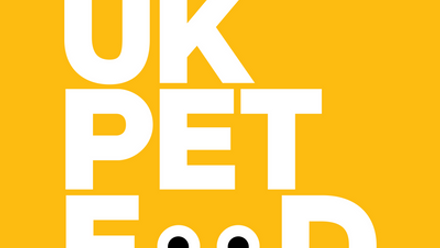PFMA RESPONSE TO TRUST ME I’M A VET: THERE IS STRINGENT LEGISLATION TO ENSURE SAFE PETFOODS
Following last night’s episode of ‘Trust Me I’m a Vet’, PFMA would like to reassure pet owners that they should not be concerned about arsenic levels in fish based pet foods as there is specific legislation to ensure safety from contaminants such as arsenic. Directive 2002/32/EC on undesirable substances in animal feed (as amended) sets maximum permitted safe levels and manufacturers are required by law to comply with these levels. PFMA was disappointed at the number of conclusions drawn by the BBC presenter based on very little scientific evidence.
PFMA members are committed to compliance, and the safety and wellbeing of animals is at the heart of everything they do. PFMA members regularly test their own products to ensure compliance with EU legislation. We are confident the foods produced are safe and contribute to the health and wellbeing of pets. Furthermore, it is widely recognised by the veterinary profession that pets are now living longer, healthier lives and the widespread feeding of commercially prepared pet food has played a key role in this.
To address any concerns pet owners may have, PFMA provides the following Questions and Answers to expand more fully on the issues raised during the programme.
Questions and Answers
It may be helpful to have some additional background information on arsenic: Arsenic is naturally occurring and found in soil, water, plants and animals. Arsenic has been in food for as long as people have been eating food and because arsenic exists in soil and water, incorporation into most plants and food including flour, fruit, poultry, rice and vegetables is unavoidable. Arsenic exists in two forms - organic and inorganic, both of which occur naturally. Whilst inorganic arsenic is toxic, organic arsenic is not considered by health officials to be of toxicological concern. The European Food Safety Authority (EFSA) published two scientific opinions in 2005 and 2010 confirming this to be the case. Based on scientific advice that chronic exposure to arsenic can have an impact on health, authorities like the European Commission set maximum limits for arsenic in foods and animal feed, including pet food.
Do fish based commercial pet foods have harmful levels of arsenic in them? No, as there is specific legislation in place to ensure safety from undesirable substances such as arsenic. Furthermore, research has shown that when arsenic is detected in fish and seafood, it is predominantly present as organic arsenic (arsenobetaine – 90%), which is confirmed by EFSA to be of no toxicological concern. The proportion of harmful inorganic arsenic in fish and seafood is therefore very small. According to EFSA, inorganic arsenic in fish/marine ingredients represents between 2 % and 3.5 % of the measured total arsenic in these ingredients.
How are contaminants legislated in animal feed? There is specific legislation to ensure safety from contaminants in animal feed which also includes pet food. Directive 2002/32/EC on undesirable substances in animal feed (as amended) sets maximum levels for undesirable substances (more commonly known as contaminants) and this legislation also applies to imported products. It lays down a list (annex 1 of the legislation) of undesirable substances and specifies the limits for which the presence of these substances in animal feeds is forbidden. The list includes substances such as lead, cadmium, arsenic, mercury, aflatoxin B1 and dioxins and it is regularly updated to include the latest scientific and technical knowledge. More information is also available from the Food Standards Agency.
What is an undesirable substance? Legislation describes an undesirable substance as any substance or product, (with the exception of pathogenic agents), present in and/or on the product intended for animal feed (including pet food), which presents a potential danger to animal or human health, to the environment or could adversely affect livestock production.
Who is responsible for enforcing/policing this legislation? The responsibility is divided between central and local authorities. The central authorities are the Food Standards Agency (FSA), Department for Environment, Food and Rural Affairs (Defra) and the devolved Agriculture/Rural Affairs Departments and their agencies (e.g. the Veterinary Medicines Directorate and the Animal & Plant Health Agency). At the local level, in Great Britain, Environmental Health and Trading Standards Services carry out much of the enforcement of feed law in local authorities.
There is advice from government health organisations on the consumption of fish with high mercury content for people, are there any such guidelines for cats? No. This isn’t necessary as the maximum safe limits for mercury and other undesirable substances set down in legislation assumes that complete pet food will be fed on a daily basis and the safety limits are set accordingly. Most pet foods are made from a recipe using several ingredients. These ingredients will be listed under ‘composition’ in descending order of weight.
If the raw fish is sourced from polluted waters outside UK or European waters, is it subject to any tests prior to use in the pet food? Irrespective of the provenance of the ingredient all pet food sold in the EU must comply with EU legislation including maximum permitted levels of undesirable substances. As mentioned earlier, Directive 2002/32/EC on undesirable substances in animal feed (as amended) sets maximum permitted safe levels and manufacturers are required by law to comply with these levels.
When a label says meat and animal derivatives (4% chicken) on the pet food label does this really mean that there is only 4% meat in the products? The pet food industry works hard to help consumers understand the legislation particularly surrounding labelling. For example, when a pet food label states 4% of a certain meat ingredient, this does not mean that the product contains only 4% meat. The 4% declaration is a legal labelling requirement which represents the minimum percentage content of the named ingredient guaranteed to be present by the manufacturer. Each recipe includes a blend of different ingredients which are all combined into a food which will meet, in part or entirely, the daily nutritional requirements of the pet.
Why do pet food companies use such terms instead of listing the ingredients? Current legislation means that manufacturers can label ingredients by category e.g. meat and animal derivatives, or by providing a full list of the meat ingredients present. Industry uses by-products from the human food chain, because of this, raw material supplies can vary during the year. Manufacturers may therefore use ingredients from different animal species based on supply levels. All the materials selected are of equal quality and provide the same nutritional benefits to the animal. Listing ingredients by category means some producers can select ingredients based on supply without having the high cost of changing labels constantly. This means they can deliver an economical product of high quality. For consumers who prefer to buy a pet food with a full ingredients list, there are many products available on the market.
Why don’t pet food labels provide more information on ingredients?
There is limited space on a pet food label and it is important that the legally required information (e.g. description, directions for use, ingredients and feeding guidelines) is clear to the consumer. To support consumers, pet food manufacturers often provide full product information on company websites. All companies provide contact details to allow consumers to obtain further information.
